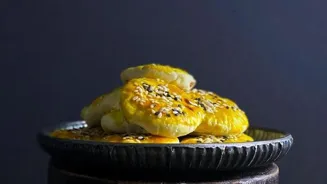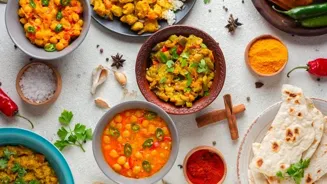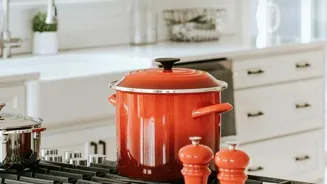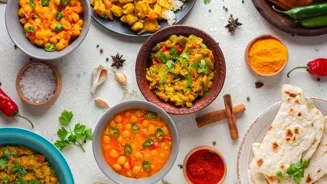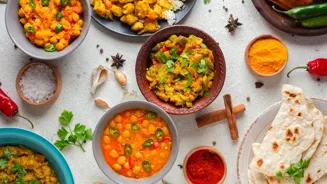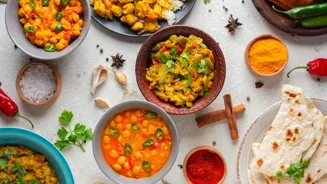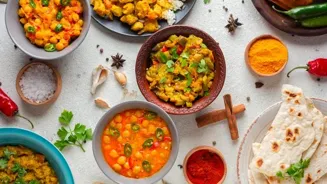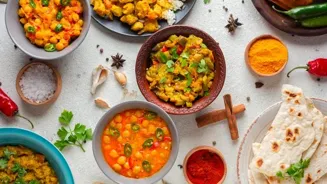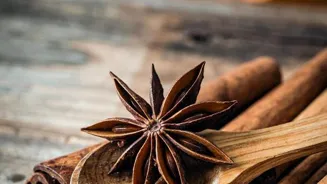Discover the art of making Authentic Indian Breads at home - a delicious journey awaits! Uncover recipes and techniques
Namaste, food lovers! Craving that warm, comforting aroma of freshly made Indian bread
wafting through your kitchen? Forget the store-bought rotis and naans. Today, we're diving deep into the heart of Indian cuisine to unlock the secrets of making authentic Indian breads right in your own home.
From the humble roti to the celebratory naan, mastering these basics will elevate your Indian meals to a whole new level. So, grab your rolling pin, don your apron, and let's get started on this delicious journey!
We shall explore some simple recipes of making authentic Indian breads, techniques for making it perfect and what we can do to make it even scrumptious!
Roti making: technique, key steps, practice for perfect results
Let's begin with the quintessential Indian bread: the roti, also known as chapati. This unleavened flatbread is a staple in most Indian households and is incredibly versatile. Its simplicity lies in its ingredients – just whole wheat flour (atta), water, and a touch of salt.
But making a soft, perfectly puffed roti requires a little bit of technique. First, knead the dough well, adding water gradually until it forms a smooth, pliable ball. Rest the dough for at least 30 minutes to allow the gluten to relax, resulting in softer rotis.
The rolling is key; aim for a thin, even circle. On a hot tava (griddle), cook the roti on both sides until small bubbles start to appear. Finally, puff it up directly over an open flame or on the tava using a clean cloth.
The puffing is what makes the roti soft and airy, a sign of a well-made chapati. Practice makes perfect, so don't be discouraged if your first few attempts aren't perfect circles. Keep rolling and cooking and enjoy the process!
Paratha: Layered flatbread with ghee, stuffed options, best hot
Next, let's move on to the paratha, a close cousin of the roti but with a delightful twist. Unlike the plain roti, the paratha is often layered with ghee (clarified butter) and sometimes even stuffed with vegetables or lentils.
The basic dough is the same as for roti, but the layering technique is what sets it apart. Roll out the dough into a circle, spread a thin layer of ghee, fold it in half, spread more ghee, and fold it again to form a triangle or square.
Roll it out gently to the desired thickness and cook it on a hot tava with ghee until golden brown and crispy. Stuffed parathas are a whole other level of deliciousness. Common fillings include potatoes (aloo paratha), cauliflower (gobi paratha), and lentils (dal paratha).
The key is to ensure the filling is cooked and seasoned well before stuffing it into the dough. Seal the edges tightly to prevent the filling from spilling out during rolling and cooking. Parathas are best enjoyed hot off the tava with a dollop of butter or a side of yogurt.
Exploring the art of making soft, fluffy naan bread at home with simple ingredients and techniques
Now, let's explore the naan, the soft, leavened flatbread that is often associated with restaurant dining. While it might seem intimidating to make at home, naan is surprisingly easy once you understand the basics.
The dough typically includes all-purpose flour (maida), yeast, sugar, salt, yogurt, and milk or water. The yeast is what gives naan its characteristic fluffy texture. Allow the dough to rise for at least an hour or two until it has doubled in size.
Divide the dough into small balls, roll them out into an oval shape, and cook them on a hot tava or ideally in a tandoor oven. Since most of us don't have a tandoor at home, a cast iron skillet or even an oven can work well.
Brush the naan with butter or ghee immediately after cooking to keep it soft and flavorful. Garlic naan, butter naan, and cheese naan are popular variations that can be easily made by adding the respective ingredients to the dough or brushing them on top before cooking.
This will add more flavors to it and give a delicious twist as well.
Delicious poori recipe with tips for perfect frying
Moving on, we have poori, the deep-fried delight that is a treat for special occasions. Poori dough is pretty similar to roti dough, but it is rolled out into smaller circles and deep-fried until it puffs up into a golden-brown balloon.
The key to making perfect pooris is to ensure the oil is hot enough. If the oil isn't hot enough, the pooris will absorb too much oil and become soggy. If the oil is too hot, they will burn quickly. Roll the pooris evenly and don't overcrowd the pan while frying.
Serve hot with potato curry (aloo sabzi) or chickpea curry (chole) for a truly satisfying meal. You can also explore different flours or make it with a mix of flours for better taste or making more soft and tasty. The recipe can be tweaked as per each one's requirement and taste.
Do ensure the recipe is in right proportion to enable it to make a good dish.
Bhatura: Punjabi deep-fried bread paired with chole curry
A lesser known but equally delicious bread is the bhatura. Bhatura is to poori what naan is to roti – a leavened, deep-fried bread that is a Punjabi specialty. Bhatura dough typically includes all-purpose flour, yeast, yogurt, and a touch of sugar and salt.
After the dough has risen, it is rolled out into a large oval shape and deep-fried until golden brown and puffy. Bhature are traditionally served with chole (chickpea curry) to make the famous dish, chole bhature. The combination of the fluffy bhatura and the spicy chole is a match made in heaven.
The taste of both combines well and gives it a great taste. A mix of both can be tried and tasted. One can also try with different flours and recipes for bhatura to make it of their own choice. A great taste awaits for those who know the art of cooking.
South Indian dosa: versatile fermented pancake, crispy & tangy, served with sambar & chutney
Finally, let's talk about dosa, a South Indian staple that has gained popularity all over the world. While technically a pancake made from fermented batter, dosa is often considered a bread due to its versatility and role as a staple food.
The batter is made from rice and urad dal (black lentils) that are soaked, ground, and fermented overnight. The fermentation process gives dosa its slightly tangy flavor and light, crispy texture.
Dosa is cooked on a hot griddle, spread thinly into a circular shape, and cooked until golden brown and crispy. It can be served plain or filled with a variety of fillings, such as potatoes (aloo masala), onions, or cheese. Sambar and coconut chutney are the traditional accompaniments to dosa.
Making dosa requires a bit of patience and practice, but the end result is well worth the effort. It can be a bit tricky but with practice and a lot of patience it can be definitely achieved.
Making Indian breads at home connects you to culinary heritage
Making Indian breads at home is a rewarding experience that allows you to connect with your culinary heritage and enjoy fresh, delicious food. Don't be afraid to experiment with different flours, fillings, and techniques to find what works best for you.
With a little practice, you'll be able to create authentic Indian breads that will impress your family and friends. Happy cooking!
AI Generated Content. Glance/InMobi shall have no liability for the content